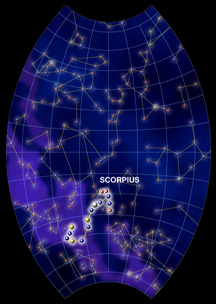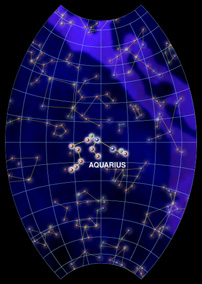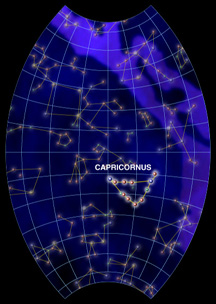The constellation, Pegasus. To see the Winged Horse, you must imagine the constellation in the image flipped over.
Click on image for full size
Windows to the Universe original image
Pegasus
The constellation, Pegasus, is a winged horse. Only the front half of the horse is in the sky. Can you see a horse in the picture? Imagine it upside-down! Then you will see a body with a neck and two legs. The body is called the "Square of Pegasus". It is easy to find the constellation if you first find the square.
The story of Pegasus is found in Greek mythology. The horse became friends with the warrior Bellerophon. Once, Bellerophon tried to fly to Mount Olympus on top of Pegasus. Zeus got very angry, and sent a fly to sting Pegasus. Bellerophon fell off of the horse, but Pegasus made it to Mount Olympus, where he stays.
If you live north of the Equator, look for Pegasus starting in the summer and through most of the fall. If you live south of the Equator, the winged horse shines near the end of winter and through spring.
You might also be interested in:

How did life evolve on Earth? The answer to this question can help us understand our past and prepare for our future. Although evolution provides credible and reliable answers, polls show that many people turn away from science, seeking other explanations with which they are more comfortable.
...more
In Greek mythology, Zeus (Jupiter in Roman mythology) was the king of heaven and Earth and of all the Olympian gods. He was also known as the god of justice. He was named king of the gods in the special
...more
The fall constellation Andromeda is a Princess. She looks like a "V"! Andromeda is close to the north pole, so only a few people in the Southern Hemisphere can see it in the spring. Andromeda's parents
...more
Some constellations do not really look like their names. It takes a lot of imagination to picture the stars of Pegasus as a winged horse, for example. But Scorpius really looks like a scorpion! It has
...more
Aquarius is also known as the Waterbearer. There are several myths about this constellation. In Greek mythology, Aquarius was the young boy, Ganymede. Zeus sent Aquila to kidnap Ganymede. The boy became
...more
The constellation Cancer is a crab. Look for Cancer from December through June. It's hard to see Cancer because the stars are so dim. To find Cancer, first find Gemini and Leo. Cancer is right between
...more
Canis Major is known as the Great Dog. In Greek myth, it is one of Orion's hunting dogs. Many cultures saw the shape of a dog in this constellation. Sirius is the brightest star in the sky. It is also
...more
The constellation Capricornus is a goat. Many years ago, people thought this constellation was a gate to the Heavens. Souls would go through it after a person died. The Greeks thought it was a sea-goat.
...more















